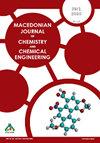Highly sensitive detection of Cr(VI), Pb(II) and Cd(II) ions by a new fluorescent sensor based on 4-amino-3-hydroxynaphthalene sulfonic acid-doped polypyrrole
IF 0.6
4区 化学
Q3 CHEMISTRY, MULTIDISCIPLINARY
Macedonian Journal of Chemistry and Chemical Engineering
Pub Date : 2020-10-14
DOI:10.20450/mjcce.2020.1978
引用次数: 3
Abstract
A new electrosynthesized, fluorescent 4-amino-3-hydroxynaphthalene-1-sulfonic acid-doped polypyrrole (AHNSA-PPy) was used for the detection of Cr(VI), Pb(II) and Cd(II) heavy metallic ions. The optical properties of AHNSA-PPy were studied by UV-VIS absorption and fluorescence spectrometry in diluted DMSO solutions. UV-VIS spectrum showed a main band at 260 nm, a moderate band at 240 nm, and shoulders at 285, 295, 320 and 360 nm, whereas the fluorescence spectrum presented an excitation peak at 330 nm and a main emission peak at 390 nm with a shoulder at 295 nm. The effects of heavy metallic ions, including Cr(VI), Pb(II), and Cd(II), on the AHNSA-PPy UV-VIS absorption and fluorescence spectra were investigated. AHNSA-PPy fluorescence spectra were strongly quenched upon increasing the Cr(VI), Pb(II) and Cd(II) concentrations. Linear Stern-Volmer relationships were established, and polynomial equations for Pb(II) and Cd(II) were obeyed, indicating the existence of a AHNSA-PPy dynamic fluorescence quenching mechanism for Cr(VI) and a combination of dynamic and static fluorescence quenching for Pb(II) and Cd(II). The AHNSA-PPy sensor showed high sensitivity for fluorescence detection of the three heavy metallic ions, with very low limits of detection (3σ) of 1.4 nM for Cr(VI), 2.7 nM for Cd(II) and 2.6 nM for Pb(II). Therefore, this very sensitive quenching fluorimetric sensor is proposed for the detection of trace, toxic heavy metallic ions in the environment.基于4-氨基-3-羟基萘磺酸掺杂聚吡咯的新型荧光传感器对Cr(VI)、Pb(II)和Cd(II)离子的高灵敏度检测
一种新的电合成荧光4-氨基-3-羟基萘-1-磺酸掺杂聚吡咯(AHNSA-PPy)用于检测Cr(VI)、Pb(II)和Cd(II)重金属离子。采用紫外-可见光谱法和荧光光谱法研究了AHNSA-PPy在DMSO稀溶液中的光学性质。UV-VIS光谱在260nm处显示主带,在240nm处显示中等带,在285295320和360nm处显示肩峰,而荧光光谱在330nm处显示激发峰,在390nm处显示主发射峰,在295nm处显示肩峰。研究了重金属离子Cr(VI)、Pb(II)和Cd(II)对AHNSA PPy UV-VIS吸收和荧光光谱的影响。AHNSA-PPy荧光光谱随着Cr(VI)、Pb(II)和Cd(II)浓度的增加而强烈猝灭。建立了线性Stern-Volmer关系,Pb(II)和Cd(II)服从多项式方程,表明Cr(VI)存在AHNSA-PPy动态荧光猝灭机制,Pb(Ⅱ)和Cd(Ⅱ)存在动态和静态荧光猝灭的组合。AHNSA-PPy传感器对三种重金属离子的荧光检测显示出高灵敏度,Cr(VI)的检测限(3σ)非常低,为1.4nM,Cd(II)的检测极限为2.7nM,Pb(II)为2.6nM。因此,这种非常灵敏的猝灭荧光传感器被提出用于检测环境中的痕量、有毒重金属离子。
本文章由计算机程序翻译,如有差异,请以英文原文为准。
求助全文
约1分钟内获得全文
求助全文
来源期刊
CiteScore
1.60
自引率
20.00%
发文量
14
审稿时长
>12 weeks
期刊介绍:
Macedonian Journal of Chemistry and Chemical Engineering (Maced. J. Chem. Chem. Eng.) is an official publication of the Society of Chemists and Technologists of Macedonia. It is a not-for-profit open acess journal published twice a year. The journal publishes original scientific papers, short communications, reviews and educational papers from all fields of chemistry, chemical engineering, food technology, biotechnology and material sciences, metallurgy and related fields. The papers published in the Journal are summarized in Chemical Abstracts.

 求助内容:
求助内容: 应助结果提醒方式:
应助结果提醒方式:


